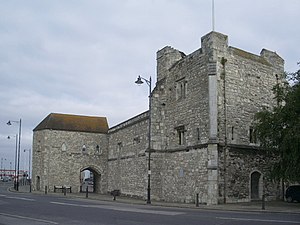God's House Tower
| God's House Tower | |
|---|---|

God's House tower looking west from The Platform
|
|
|
Location within Southampton
|
|
| General information | |
| Type | Gateway |
| Architectural style | Medieval |
| Location | Winkle Street/Town Quay, Southampton |
| Coordinates | 50°53′47″N 1°24′10″W / 50.8963°N 1.4029°W |
| Current tenants | Vacant |
| Construction started | circa 1300 |
| Completed | early 15th century |
| Owner | Southampton City Council |
| Technical details | |
| Floor count | 2/3 |
God's House Tower is a late 13th century gatehouse into the old town of Southampton, England. It stands at the south-east corner of the town walls and permitted access to the town from the Platform and Town Quay. It has served as the town gaol and housed the Museum of Archaeology. The building is Grade II listed and a scheduled ancient monument.
The original gatehouse was a simple affair, built in the late 13th century and known as the Saltmarsh Gate, as it led to marshlands outside the town. Being close to God's House Hospital, which had been founded in 1168 by Gervase le Riche as a refuge for travellers, the gateway became known as the God's House gateway. Following the French raid on the town in 1338, the town's defences were strengthened and the gateway was reinforced.
The tower was further extended in 1417 by the addition of a two-storey gallery and a three-storey tower, to the east of the gateway; this was one of the earliest forts built specifically to carry cannon and had eight gunports and rooftop firing points. This spur enabled the town gunner to protect the sluices that controlled the flow of seawater into a tidal moat used to power the water mill under the tower. The town gunner was also responsible for making the gunpowder and gunshot which he stored, together with the guns, in the gallery of the tower.
By the start of the 17th century, the building had fallen into disrepair as the town no longer needed strong defences and in 1707 part of the building was being used as a house of correction. From 1786, it became the town gaol; at this time, the tower was known as the "Lambcote Tower". In 1855, a new prison was opened in Ascupart Street and the prison in the tower was closed.
The building stood empty until 1876, when it was requisitioned by the Southampton Harbour Board for use as storage, although the groundfloor of the gatehouse was retained for use as a mortuary. At this time, the buildings were restored and the exterior was cleaned.
In 1957, approval was sought to convert the building into a museum: four years later in 1961, the Museum of Archaeology opened to the public and then closed in September 2011.
In 1877, Sir Frederick Perkins, M.P. for Southampton, presented the town with a terracotta statue of Prince Albert which was placed at the eastern end of the building. Perkins had paid £300 for the statue in 1869 and had presented it to the Albert Infirmary at Bishops Waltham; on the closure of the infirmary, he donated it to the town of Southampton. The statue was designed by William Theed and made at the terracotta works in Lambeth.
...
Wikipedia

